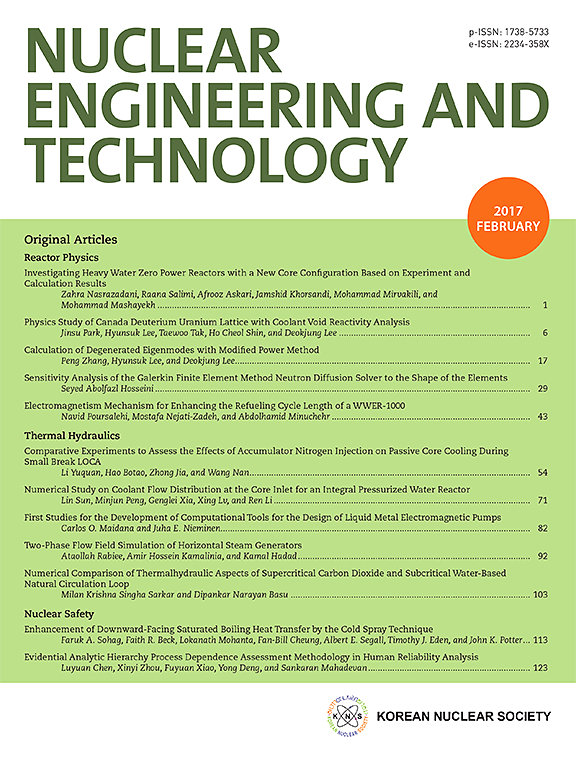双通道设施自然循环计算模型研究
IF 2.6
3区 工程技术
Q1 NUCLEAR SCIENCE & TECHNOLOGY
引用次数: 0
摘要
目前的工作研究了一个计算模型,以研究空气进入和事故发生时自然循环过程中的热和水力空气行为。该模型由 RHYS 耦合 ASYST VER 4 软件包完成。本研究考虑的试验设备是双垂直通道设备,由两个平行通道组成,分别连接到上下风箱。通过使用不同的均匀等流量(100-1400 W/m)和不同的外表面温度(278、288、298 和 308 K)分析轴向温度和速度分布,对加热和冷却通道中的流场进行了综合表征。由于自然对流,在最大光斑之后记录到温度和速度反转。温度从 278 K 升至 308 K 时,空气和内壁温度分别平均上升了 25.51 和 25.19°,而在加热通道中,冷却强度高(278 K)时空气流速增加,在冷却通道中,冷却强度低(308 K)时流速增加。对流传热用传热系数表示,用于计算努塞尔特数。此外,ASYST 模型还与文献来源的数据进行了验证,结果表明两者非常吻合。本文章由计算机程序翻译,如有差异,请以英文原文为准。
Investigation of computational model for the natural circulation at dual channel facility
The current work investigates a computational model to study the thermal and hydraulic air behavior during the natural circulation at air ingression and accidents. This is done with the RHYS coupling ASYST VER 4 package. The test facility considered for the present study is a dual vertical channel facility comprised of two parallel channels connected to the upper and lower plenum. The flow fields in the heated and cooled channels were comprehensively characterized by analyzing axial temperature and velocity distributions using varied uniform iso-flux (100–1400 W/m2) and different outer surface temperatures (278, 288, 298, and 308 K). Temperature and velocity reversal recorded after maximal spots due to natural convection. The temperature rise from 278 to 308 K gave an average of 25.51 and 25.19° increase in air and inner wall temperatures, respectively, while air velocity increases at high cooling intensity (278 K) within the heated channel, in the cooled channel, low cooling intensity (308 K) resulted in higher velocity. The convective heat transfer is represented in terms of heat transfer coefficients, which are used to compute the Nusselt number. Additionally, the ASYST model was validated with data from literature sources, indicating strong agreement.
求助全文
通过发布文献求助,成功后即可免费获取论文全文。
去求助
来源期刊

Nuclear Engineering and Technology
工程技术-核科学技术
CiteScore
4.80
自引率
7.40%
发文量
431
审稿时长
3.5 months
期刊介绍:
Nuclear Engineering and Technology (NET), an international journal of the Korean Nuclear Society (KNS), publishes peer-reviewed papers on original research, ideas and developments in all areas of the field of nuclear science and technology. NET bimonthly publishes original articles, reviews, and technical notes. The journal is listed in the Science Citation Index Expanded (SCIE) of Thomson Reuters.
NET covers all fields for peaceful utilization of nuclear energy and radiation as follows:
1) Reactor Physics
2) Thermal Hydraulics
3) Nuclear Safety
4) Nuclear I&C
5) Nuclear Physics, Fusion, and Laser Technology
6) Nuclear Fuel Cycle and Radioactive Waste Management
7) Nuclear Fuel and Reactor Materials
8) Radiation Application
9) Radiation Protection
10) Nuclear Structural Analysis and Plant Management & Maintenance
11) Nuclear Policy, Economics, and Human Resource Development
 求助内容:
求助内容: 应助结果提醒方式:
应助结果提醒方式:


